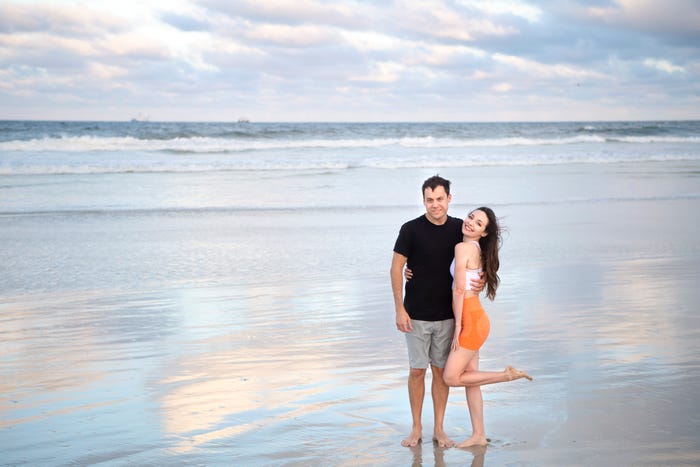A couple that quit their jobs in their 20s explains why the 4% rule of early retirement is overrated — and why they felt comfortable quitting before they reached ‘full financial independence’
5 min readA couple that quit their jobs in their 20s explains why the 4% rule of early retirement is overrated — and why they felt comfortable quitting before they reached ‘full financial independence’

- The 4% rule is a popular method among the FIRE community for determining retirement spending.
- It suggests that if you take the amount you spend a year and multiply it by 25, you’ll have “enough” to retire.
- Early retirees Lauren and Steven Keys explain why they don’t buy into the rule.
The 4% rule is popular among the Financial Independence, Retire Early (FIRE) community.
It can help prospective early retirees figure out how much money they can spend in retirement without running out.
The rule suggests that you can safely withdraw 4% annually from your nest egg. For example, if you retire with $1 million, you should be able to withdraw $40,000 from your retirement funds each year without running out of money. If you retire with $5 million, you can withdraw $200,000 a year. To figure out your number, take your annual spend and multiply it by 25.
When Lauren and Steven Keys set out to achieve financial independence and allow themselves the freedom to quit their 9-to-5s, they kept this formula in mind.
“At the very beginning of our journey, we both accepted that as a number that mattered to us,” Steven told Business Insider.
But then they did an early retirement “test run” of sorts in 2015: They quit full-time work and traveled to Hawaii for six months. The couple estimated they had about seven years’ worth of expenses saved up at the time, but they didn’t end up having to touch any of it since they were still bringing in income from part-time gigs.
Stephen, a former high school physics teacher, tutored students online and locally for about 10 hours a week. Lauren negotiated a part-time, remote work situation with her previous full-time employer. They also launched a small-scale photography business.
What they realized is that early retirement doesn’t necessarily mean they’ll never work again.
“There’s this misconception about early retirement that you’ll never make another penny ever again and just sit on the beach all day for the rest of your life,” said Steven. “We’re never going to stop making any money whatsoever. So this idea of needing 25 times your annual expenses to feel like you can quit your full-time job became kind of laughable to us. If you have 20 times your annual expenses or even 15 times your expenses, there’s no way you’re ever going to spend that down if you’re the type of person who saves that much, to begin with.”
The Keys encourage other people to consider this version of early retirement that incorporates part-time work and even test it out like they did in Hawaii and again, a few years later, when they took a seven-month road trip to every national park in the United States.
“That six months in Hawaii was only a few years into this journey and it really proved the model to me,” said Lauren. “We were working maybe 10 hours a week, and it was covering all of our expenses. It was like a mini-retirement that proved we really don’t need a lot of money to live and be happy. We could go outside every day, explore, and do what we want and the numbers are still working. This concept does work.”
Granted, they set themselves up to take monthslong trips by saving most of their income and building a six-figure net worth.
“We very much felt like we do not need the income from our jobs,” said Steven. “And so we approached employers with more of, I’ll call it a nice ultimatum. For example, when we went on our trip to the National Parks, I went to my boss and said, ‘Hey, I’m going on a seven-month trip. It’s a thing I want to do. It’s happening. But also, I don’t want to leave you high and dry. So if you want me to do some amount of work from the road while I’m gone, I’m open to it. If not, that’s fine. I quit.'”
Today, they consider themselves fully financially independent, but they still have a variety of revenue streams that more than sustain their lifestyle.
Steven does some freelance work for his former employer (a tutoring company), which is their largest source of active income. Still, he is directing much of his time to an online tutoring service, CramBetter, that he co-founded in 2023.
Lauren has one social media client she spends a couple of hours a month working with. She also runs her and Steven’s financial independence blog, Trip of a Lifestyle.
They also still run their photography business and earn rental income from a fully paid-off investment property they own in Gainesville. The couple’s primary home is also paid off, which BI verified by reviewing county public records.
“Since we enjoy a healthy dose of productivity in our lives and will probably never stop earning, we’ll also probably never actually live off of the prescribed 4% of our investments each year,” said Steven. “For us, reaching financial independence is more about being free to direct the course of our lives with concern only for what’s really important to us, not a need for money.”
Discover more from Slow Travel News
Subscribe to get the latest posts sent to your email.



